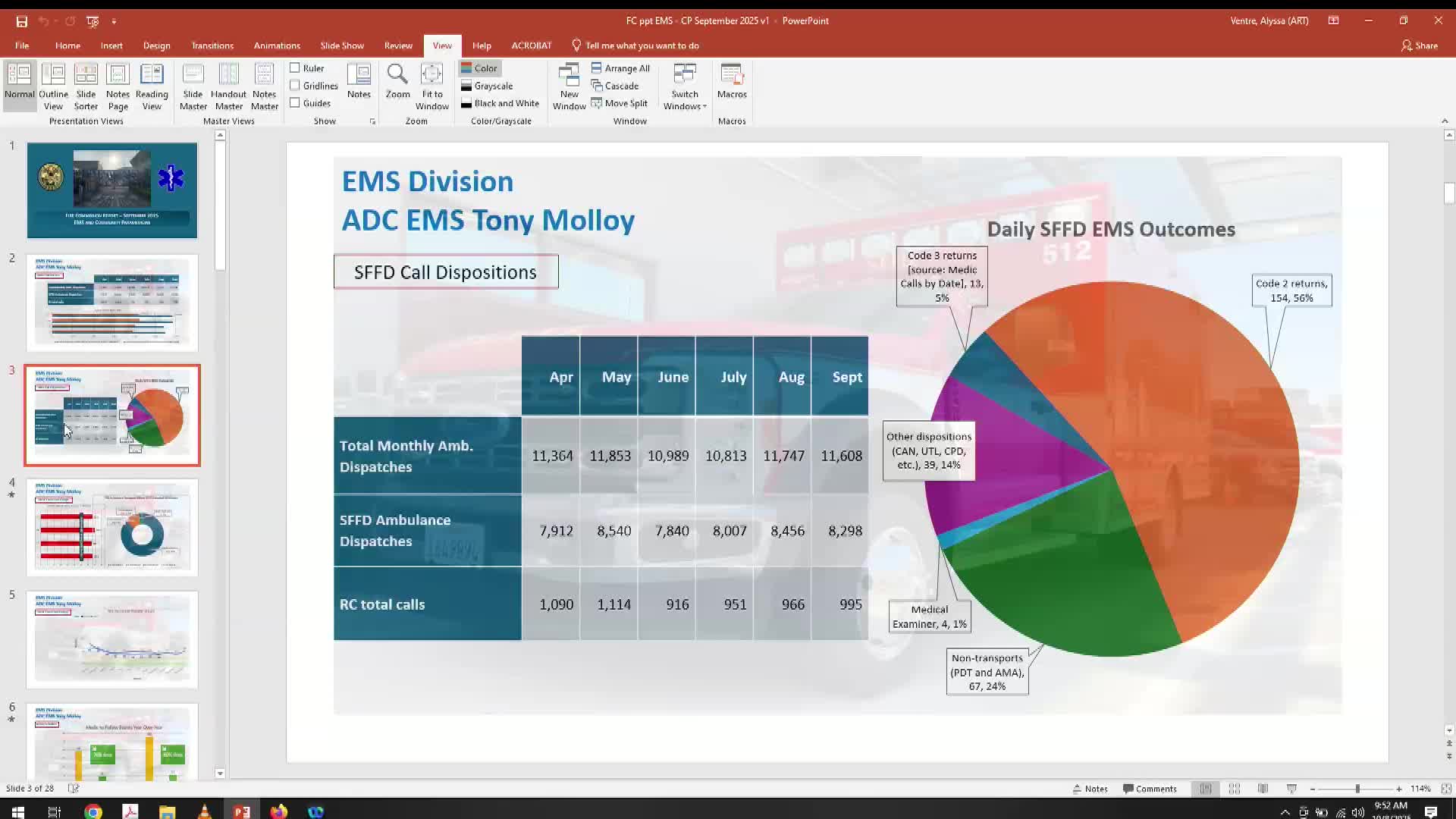Fire department reports shorter hospital handoff times, outlines community paramedicine work
October 08, 2025 | San Francisco City, San Francisco County, California
This article was created by AI summarizing key points discussed. AI makes mistakes, so for full details and context, please refer to the video of the full meeting. Please report any errors so we can fix them. Report an error »

Assistant Deputy Chief Tony Malloy and Assistant Deputy Chief April Sloan briefed the Fire Commission on Sept. and Sept. reporting trends for EMS and Community Paramedicine during the Oct. 8 meeting.
Malloy said emergency medical services has seen reduced time at hospitals (APOD) compared with earlier 2025 levels. He described technical reporting changes and coordination with hospitals and state reporting systems designed to better align recorded APOD times with actual transfer times; the department said reductions have freed an estimated five hours a day of ambulance availability compared with last year. “We expect in the next month or two that those numbers are going to start to come down,” Malloy said.
Why it matters: Ambulances tied to hospitals for longer periods reduce available response capacity in the city. Shorter APOD times increase daily in‑service hours for crews.
Other EMS data and operational items
- Medic operations: year‑over‑year reductions in medic follow volumes were reported (large percentage drops noted versus prior year), though leaders said more work remains.
- Cardiac arrest outcomes: Malloy highlighted a witnessed cardiac arrest at City Hall where early bystander CPR and AED use preceded a successful transport; commissioners discussed improving AED signage and public awareness in City Hall and other public buildings.
- Narcan and overdose response: drug‑overdose interventions continue at steady levels reported for September.
Community Paramedicine and alternative responses
April Sloan reported community paramedicine responses at about 1,700 calls for the month reported and an average daily caseload of 58. Her team made 32 involuntary psychiatric hold evaluations (majority for grave disability) and referred many individuals to sobering centers, shelters and the Gary Stabilization Unit; Sloan said the division is the largest referring agency to that unit. The Street Crisis and EMS teams also participated in Alternative Response Research Collective site visits and joint exercises with other agencies.
Police referrals and 51.50 holds
Commissioners asked about Section 5150 (involuntary psychiatric holds) calls and SFPD referrals; Sloan said SFPD referrals accounted for about 28% of the division’s special calls in September, a slight increase, and that police and EMS remain partners in triage for behavioral health incidents.
Ending
Commissioners asked the department to continue reporting APOD and medic follow trends as the department works with hospitals and data vendors to reconcile reported times and to consider simple measures—signage or public education—to ensure faster AED access in City Hall and other public facilities.
Malloy said emergency medical services has seen reduced time at hospitals (APOD) compared with earlier 2025 levels. He described technical reporting changes and coordination with hospitals and state reporting systems designed to better align recorded APOD times with actual transfer times; the department said reductions have freed an estimated five hours a day of ambulance availability compared with last year. “We expect in the next month or two that those numbers are going to start to come down,” Malloy said.
Why it matters: Ambulances tied to hospitals for longer periods reduce available response capacity in the city. Shorter APOD times increase daily in‑service hours for crews.
Other EMS data and operational items
- Medic operations: year‑over‑year reductions in medic follow volumes were reported (large percentage drops noted versus prior year), though leaders said more work remains.
- Cardiac arrest outcomes: Malloy highlighted a witnessed cardiac arrest at City Hall where early bystander CPR and AED use preceded a successful transport; commissioners discussed improving AED signage and public awareness in City Hall and other public buildings.
- Narcan and overdose response: drug‑overdose interventions continue at steady levels reported for September.
Community Paramedicine and alternative responses
April Sloan reported community paramedicine responses at about 1,700 calls for the month reported and an average daily caseload of 58. Her team made 32 involuntary psychiatric hold evaluations (majority for grave disability) and referred many individuals to sobering centers, shelters and the Gary Stabilization Unit; Sloan said the division is the largest referring agency to that unit. The Street Crisis and EMS teams also participated in Alternative Response Research Collective site visits and joint exercises with other agencies.
Police referrals and 51.50 holds
Commissioners asked about Section 5150 (involuntary psychiatric holds) calls and SFPD referrals; Sloan said SFPD referrals accounted for about 28% of the division’s special calls in September, a slight increase, and that police and EMS remain partners in triage for behavioral health incidents.
Ending
Commissioners asked the department to continue reporting APOD and medic follow trends as the department works with hospitals and data vendors to reconcile reported times and to consider simple measures—signage or public education—to ensure faster AED access in City Hall and other public facilities.
View the Full Meeting & All Its Details
This article offers just a summary. Unlock complete video, transcripts, and insights as a Founder Member.
✓
Watch full, unedited meeting videos
✓
Search every word spoken in unlimited transcripts
✓
AI summaries & real-time alerts (all government levels)
✓
Permanent access to expanding government content
30-day money-back guarantee

